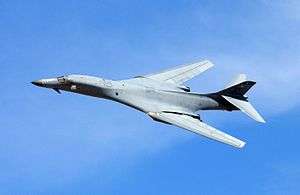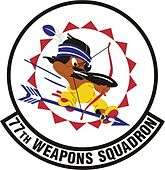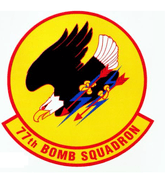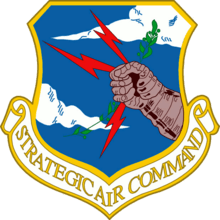77th Weapons Squadron
The 77th Weapons Squadron is a United States Air Force unit assigned to the USAF Weapons School, stationed at Dyess Air Force Base, Texas. The 77th is a Geographically Separated Unit of the 57th Wing, stationed at Nellis Air Force Base, Nevada. The mission of the squadron is to provide B-1 Lancer instructional flying.
| 77th Bombardment Squadron | |
|---|---|
 B-1B Lancer from Dyess AFB, Texas performing a fly-by during a firepower demonstration | |
| Founded | 1940 |
| Country | |
| Branch | |
| Type | Squadron |
| Role | Advanced B-1 Lancer Training |
| Part of | USAF Weapons School |
| Garrison/HQ | Dyess Air Force Base, Texas |
| Engagements | World War II
Vietnam War |
| Decorations | Distinguished Unit Citation Air Force Outstanding Unit Award with Combat "V" Device Air Force Outstanding Unit Award (12x) Republic of Vietnam Gallantry Cross with Palm |
| Insignia | |
| 77th Weapons Squadron emblem (approved 17 May 1997)[1][note 1] |  |
| 77th Bomb Squadron emblem |  |
The unit activated on 15 January 1941 at Fort Douglas, Utah. After combat operations in the Pacific theater during World War II, the 77th contributed to America's nuclear deterrent during the Cold War and formed the backbone of the Air Force's B-52 force during the Vietnam War.
Overview
The 77th provides weapons training to B-1B Lancer squadrons at Dyess Air Force Base, TX and Ellsworth AFB, SD.
History
World War II
The squadron was activated in January 1941 as a Northwest Air District medium bomber squadron, equipped with a mixture of Douglas B-18 Bolos, PT-17 Stearman trainers and early model Martin B-26 Marauders. Upon completion of training, it was assigned to the new Elmendorf Field, near Anchorage, Alaska; being one of the first Air Corps units assigned to Alaska. After the Japanese attack on Pearl Harbor, the squadron flew antisubmarine patrols over the Gulf of Alaska.
When the Japanese invaded the Aleutian Islands in June 1942, the squadron was reassigned to Fort Glenn Army Airfield on Adak Island; and began combat missions over the captured islands of Kiska and Attu. Flew combat missions with B-26 Marauders and later B-25 Mitchell medium bombers during the Aleutian Campaign, remaining in Alaska until the end of World War II in 1945 when the squadron personnel were demobilized and the unit inactivated as a paper unit in early of November 1945. SSgt Charlton Heston served as a radio operator and gunner aboard a B-25 of the 77th from 1944–45.[2]
Cold War
Reactivated as a Strategic Air Command B-29 Superfortress squadron in 1946, being trained in the midwest then reassigned to Alaska in late 1946. Mission changed from strategic bombardment training to strategic reconnaissance and mapping; engaging in very long range reconnaissance missions in the Bering Straits; North Pacific coast and Arctic Ocean coastline of the Soviet Union. Squadron performed charting and other mapping missions, most likely including ferret and ELINT missions, possibly overflying Soviet airspace.
Squadron returned to the Continental United States in 1947, being equipped with B-36 Peacemaker strategic bombers, both in the bomber and strategic reconnaissance versions. Undertook strategic bombardment training missions on a global scale, including strategic reconnaissance missions with the RB-36s until the phaseout of the B-36 from SAC in 1957.
Re-equipped with B-52D Stratofortresses and stood nuclear alert and conducted global strategic bombardment training missions until 1966. Began rotational deployments to Andersen AFB, Guam where squadron began flying conventional strategic bombardment Arc Light missions over Indochina (1966–1970). Converted to B-52G in 1971 and returned to nuclear alert status; upgrading to B-52H in 1977. Received first production B-1B Lancers in 1985 and maintained nuclear alert until taken off alert after the end of the Cold War in 1991. Performed strategic bombardment training until inactivated in 1997 as part of the drawdown of the USAF.
Modern era
Organization organized as the USAF Weapons School B-1 Division on 28 August 1992 at Nellis Air Force Base, Nevada. Replaced by the 77th Weapons Squadron in 2003. It provides training to B-1 aircrews at Dyess.
Lineage
- Constituted as the 77th Bombardment Squadron (Medium) on 20 November 1940
- Activated on 15 January 1941
- Redesignated 77th Bombardment Squadron, Medium on 9 October 1944
- Inactivated on 5 November 1945
- Redesignated 77th Bombardment Squadron, Very Heavy on 15 July 1946
- Activated on 4 August 1946
- Redesignated 77th Bombardment Squadron, Medium on 28 May 1948
- Redesignated 77th Bombardment Squadron, Heavy on 16 May 1949
- Redesignated 77th Strategic Reconnaissance Squadron, Photographic on 1 April 1950
- Redesignated 77th Strategic Reconnaissance Squadron, Heavy on 16 July 1950
- Redesignated 77th Bombardment Squadron, Heavy on 1 October 1955
- Redesignated 77th Bomb Squadron on 1 September 1991
- Inactivated on 31 March 1995
- Activated on 1 April 1997
- Inactivated on 19 September 2002
- Redesignated 77 Weapons Squadron on 24 January 2003
- Activated on 3 February 2003[1]
Assignments
- 42d Bombardment Group, 15 January 1941
- 28th Composite Group (later 28 Bombardment Group), 2 January 1942
- Eleventh Air Force, 20 October – 5 November 1945
- 28 Bombardment Group (later 28 Strategic Reconnaissance Group), 4 August 1946 (attached to 28th Strategic Reconnaissance Wing after 10 February 1951)
- 28th Strategic Reconnaissance Wing (later 28 Bombardment Wing), 16 June 1952
- 28th Operations Group, 1 September 1991 – 31 March 1995
- 28th Operations Group, 1 April 1997 – 19 September 2002
- USAF Weapons School, 3 February 2003 – present[1]
Stations
|
|
Aircraft
|
|
References
- Notes
- This emblem is based on the unofficial emblem designed for the squadron c. December 1941 by the Disney Studions.
- Citations
- Warnock, A. Timothy (20 December 2007). "Factsheet 77 Weapons Squadron (ACC)". Air Force Historical Research Agency. Retrieved 9 September 2016.
- Mecca, Pete (10 December 2013). "During World War II, Hollywood got serious". The Covington News. Archived from the original on 4 September 2015. Retrieved 24 August 2014.
Bibliography
![]()
- Maurer, Maurer, ed. (1983) [1961]. Air Force Combat Units of World War II (PDF) (reprint ed.). Washington, DC: Office of Air Force History. ISBN 0-912799-02-1. LCCN 61060979. Retrieved 17 December 2016.
- Maurer, Maurer, ed. (1982) [1969]. Combat Squadrons of the Air Force, World War II (PDF) (reprint ed.). Washington, DC: Office of Air Force History. ISBN 0-405-12194-6. LCCN 70605402. OCLC 72556. Retrieved 17 December 2016.
- Ravenstein, Charles A. (1984). Air Force Combat Wings, Lineage & Honors Histories 1947-1977. Washington, DC: Office of Air Force History. ISBN 0-912799-12-9. Retrieved 17 December 2016.


